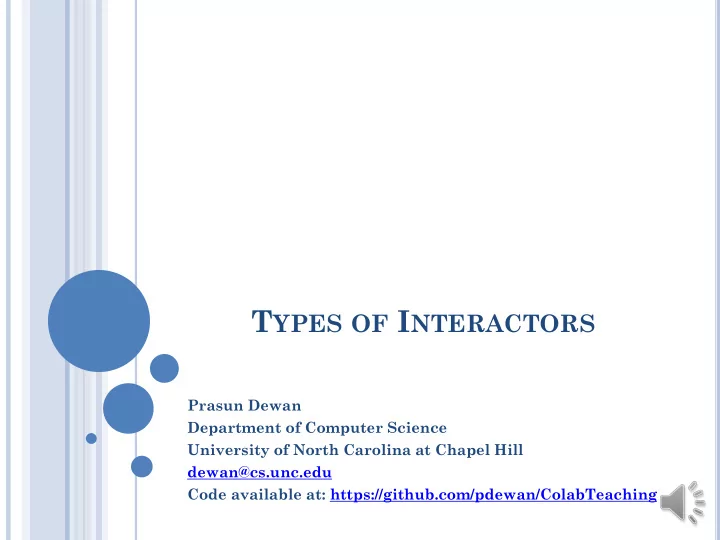

T YPES OF I NTERACTORS Prasun Dewan Department of Computer Science University of North Carolina at Chapel Hill dewan@cs.unc.edu Code available at: https://github.com/pdewan/ColabTeaching
P RE -R EQUISITES Model-Interactor Separation 2
I NTERACTOR T YPES UI Code Interactor Types of interactors? Computation Model Code 3
T YPES OF I NTERACTORS Console-based UI GUI Graphics Three levels of abstraction 4
A BSTRACTION L AYERS Console-based Toolkit-based Inetractor Window- (GUI) based Interactor (Graphics) Console Text Interactor Component Widgets (Text Component, Button, Slider) Windows Flexibility vs. Automation Tradeoff in Abstraction Design 5
A BSTRACTION L AYERS (R EVIEW ) Console-based Toolkit-based Inetractor Window- (GUI) based Interactor (Graphics) Console Text Interactor Component Widgets (Text Component, Button, Slider) Windows Flexibility vs. Automation Tradeoff in Abstraction Design 6
R ELATIONSHIP BETWEEN I NTERACTOR AND D IFFERENT KINDS OF O BJECTS Helper UI- Interactor/Editor/ Specific Objects View Helper objects can be at varying levels of abstraction Model 7
W INDOWS Window are untyped rectangular Window Client screen areas in which each point is a pixel ‘a’ ^, w1, x, y Input indicates keyboard and/or mouse operations Output draws text, shapes draw ‘a’, w1, x, y Window System user presses draws ‘a’ at cursor ‘a’ position User 8
E XAMPLE Draws the last character entered at the last position at which the mouse was clicked Draws a carat next to the character and a circle around it 9
U SING J AVA W INDOW TO D EFINE A W IDGET public class ACircledCharacterDrawer extends JFrame implements MouseListener, KeyListener { Widget = Window + Window … reusable functionality // called when an enqueued paint event for this component is dequeued public void paint (Graphics g) { super.paint(g); // clears the window // better to use FontMetrics to center circle g.drawOval(charX - X_OFFSET, charY - Y_OFFSET, DIAMETER, DIAMETER); g.drawLine(charX, charY, charX, charY - CARAT_LENGTH); Output painter g.drawString("" + lastChar, charX, charY); } Input notification public void keyTyped(KeyEvent event) { method setChar(event.getKeyChar()); } Reusable public void setChar(char newValue) { functionality lastChar = newValue; repaint();// enqueues a paint event } In Java >= 1.1 input is provided through the public void mousePressed(MouseEvent event) { observer pattern charX = event.getX(); This subclass of a window is listening to its charY = event.getY(); Notification method called by a lower-level repaint(); // enqueues a paint event own window events (registration methods 10 abstraction == callback } in constructor not shown)
W IDGETS AND T OOLKIT Widget Client Widgets are typed windows textEntered() Input callbacks are widget specific (e.g. slider moved, text changed, text inserted) getText() Output and other calls are widget specific (change text or slider setText() position) Widget Toolkit = Set of all Widgets e.g. AWT, Swing User enter a Updates text line of text User 11
W IDGET U SE E XAMPLE JTextField jTextField = new JTextField("JTextField: Edit me"); AJTextFieldListener jTextFieldListener = new Widget creation and AJTextFieldListener(jTextField); observer registration jTextField.addActionListener(jTextFieldListener); jTextField.getDocument().addDocumentListener(jTextFieldListener); public class AJTextFieldListener implements ActionListener, DocumentListener{ JTextField jTextField; public AJTextFieldListener(JTextField aJTextField) { jTextField = aJTextField; Notification of new } line entered public void actionPerformed(ActionEvent e) { System. out.println("New text entered:" + jTextField.getText()); } Notification of new public void insertUpdate(DocumentEvent e) { int newPos = e.getOffset(); character insertion char newChar = jTextField.getText().charAt(newPos); System. out.println("Character " + newChar + " inserted at " + newPos); } 12 …
A TOMIC VS C OMPOSITE W IDGETS /W INDOWS Atomic component of a widget/window tree Atomic window (JFrame) Root component is top- special level window (Frame or JFrame) JFrame Top-level window manipulated by (customizable) window manager which puts border JTextField and provides operations to move, resize, iconify it 13
C REATING , L AYING - OUT AND D ISPLAYING A H IERARCHY (Sub)tree Parent node JFrame frame = new JFrame(theTitle); layout frame.setLayout( new GridLayout(5, 2)); JTextField jTextField = new JTextField("JTextField: Edit me"); Child node … frame.add(jTextField); Link creation … frame.setSize(300, 300); Display Tree frame.setVisible( true); … Here child created independent of parent and can be re-parented In some systems a child is created as part of a parent: parent specified when child created 14
D IFFERENT KINDS OF (P REDEFINED ) H ELPER UI A BSTRACTIONS System.out, Interactor parses input Interactor System.in unparses output Interactor creates widget Widget hierarchies, defines widget Interactor Hierarchies callbacks and invokes widget calls Interactor creates windows Window hierarchies, processes mouse Interactor Hierarchies and key events, and draws shapes Additional programmer-defined objects can and should be defined (e.g. different classes of widget listeners) 15
I NTERACTOR -UI A BSTRACTION D ECOUPLING System.out, Interactor ’ Interactor System.in Widget Interactor Interactor Hierarchies Window Interactor Interactor Hierarchies An interactor can be bound to different kinds of UI abstractions A UI abstraction can be bound to different kinds of 16 interactors
S EPARATION IN C ONSOLE - BASED UI S System.out, Interactor ’ Interactor System.in Eclipse Interactor Custom interactor for launching multiple processes 17
I NTERACTORS CAN BE S TRUCTURED Interactor Interactor Interactor When user interfaces are composed Subinteractors can intract directly with models or through parent interactoes 18
S UMMARY OF C ONCEPTS IN I NTERACTORS Window, Widget, and Console Layers Calls (callbacks) invoked by higher (lower) layer on lower (higher) layer Window: Rectangular Area Input (callbacks): Key, Mouse Events Output (calls) : shape draw calls (drawLine , …) Widget: Window embellished with higher-level behavior Input (calls): arbitrary (e.g. new text changed) Output (callbacks): arbitrary (e.g. change text) Console: a text widget used to enter and display text lines Window/Widget Hierarchies: Trees associated with layouts Usually made visible after they have been created An interactor uses one of more of the UI abstractions above as helper objects Interactor and the UI abstraction objects are decoupled System.in, System.out used in different kinds of interactors 19
M ODEL /I NTERACTOR P ATTERN UI Code Interactor Types of interactors? Computation Types of models? Model Code 20
Recommend
More recommend